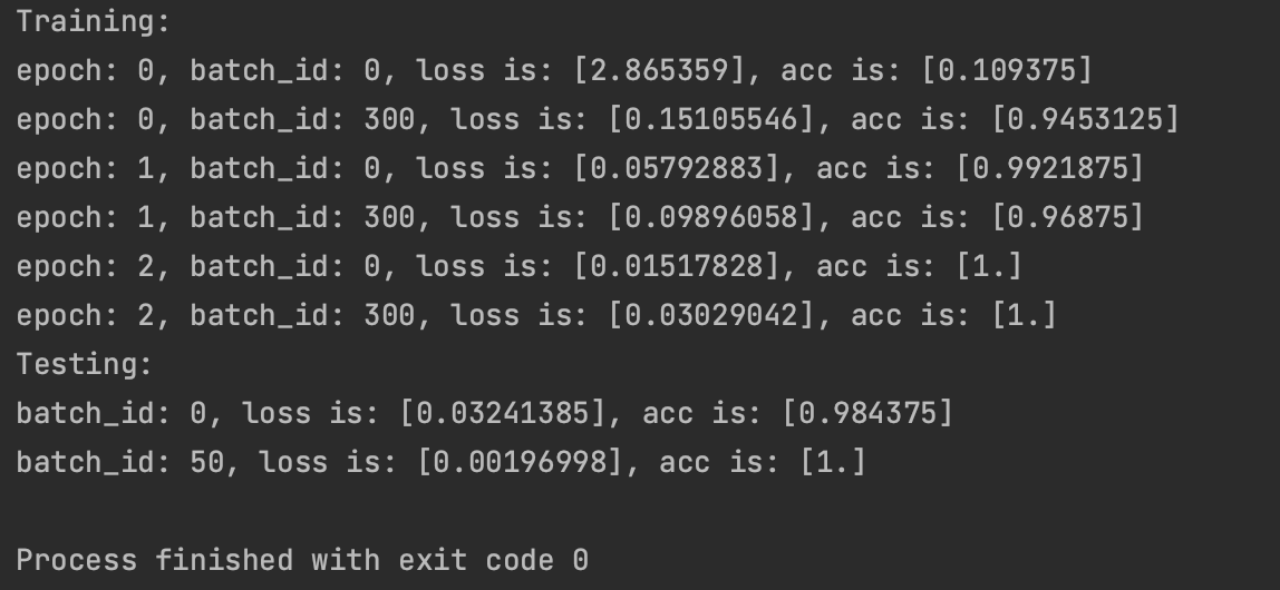import paddle
import paddle. nn. functional as F
from paddle. vision. transforms import Compose, Normalizetransform = Compose( [ Normalize( mean= [ 127.5 ] , std= [ 127.5 ] , data_format= 'CHW' ) ] )
print ( 'download training data and load training data' )
train_dataset = paddle. vision. datasets. MNIST( mode= 'train' , transform= transform)
test_dataset = paddle. vision. datasets. MNIST( mode= 'test' , transform= transform)
print ( 'load finished' )
class CNN ( paddle. nn. Layer) : def __init__ ( self) : super ( ) . __init__( ) self. conv1 = paddle. nn. Conv2D( in_channels= 1 , out_channels= 6 , kernel_size= 5 , stride= 1 , padding= 2 ) self. max_pool1 = paddle. nn. MaxPool2D( kernel_size= 2 , stride= 2 ) self. conv2 = paddle. nn. Conv2D( in_channels= 6 , out_channels= 16 , kernel_size= 5 , stride= 1 ) self. max_pool2 = paddle. nn. MaxPool2D( kernel_size= 2 , stride= 2 ) self. linear1 = paddle. nn. Linear( in_features= 16 * 5 * 5 , out_features= 120 ) self. linear2 = paddle. nn. Linear( in_features= 120 , out_features= 84 ) self. linear3 = paddle. nn. Linear( in_features= 84 , out_features= 10 ) def forward ( self, x) : x = self. conv1( x) x = F. relu( x) x = self. max_pool1( x) x = self. conv2( x) x = F. relu( x) x = self. max_pool2( x) x = paddle. flatten( x, start_axis= 1 , stop_axis= - 1 ) x = self. linear1( x) x = F. relu( x) x = self. linear2( x) x = F. relu( x) x = self. linear3( x) return x
train_loader = paddle. io. DataLoader( train_dataset, batch_size= 128 , shuffle= True )
def train ( model) : model. train( ) epochs = 3 optim = paddle. optimizer. Adam( learning_rate= 0.001 , parameters= model. parameters( ) ) print ( "Training:" ) for epoch in range ( epochs) : for batch_id, data in enumerate ( train_loader( ) ) : x_data = data[ 0 ] y_data = data[ 1 ] predicts = model( x_data) loss = F. cross_entropy( predicts, y_data) acc = paddle. metric. accuracy( predicts, y_data) loss. backward( ) if batch_id % 300 == 0 : print ( "epoch: {}, batch_id: {}, loss is: {}, acc is: {}" . format ( epoch, batch_id, loss. numpy( ) , acc. numpy( ) ) ) optim. step( ) optim. clear_grad( )
model = CNN( )
train( model)
test_loader = paddle. io. DataLoader( test_dataset, places= paddle. CPUPlace( ) , batch_size= 128 )
def test ( model) : model. eval ( ) print ( "Testing:" ) for batch_id, data in enumerate ( test_loader( ) ) : x_data = data[ 0 ] y_data = data[ 1 ] predicts = model( x_data) loss = F. cross_entropy( predicts, y_data) acc = paddle. metric. accuracy( predicts, y_data) if batch_id % 50 == 0 : print ( "batch_id: {}, loss is: {}, acc is: {}" . format ( batch_id, loss. numpy( ) , acc. numpy( ) ) )
test( model)

![[Java基础揉碎]多线程基础](http://pic.xiahunao.cn/[Java基础揉碎]多线程基础)









(特殊的输入重定向方式)(定界符))


)



)

